
Alexandra of Denmark was Queen of the United Kingdom and the British Dominions, and Empress of India, from 22 January 1901 to 6 May 1910 as the wife of King-Emperor Edward VII.
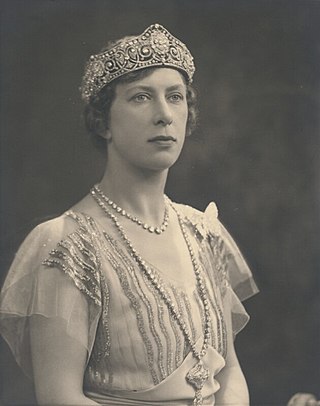
Mary, Princess Royal, was a member of the British royal family. She was the only daughter of King George V and Queen Mary, the sister of kings Edward VIII and George VI, and aunt of Elizabeth II. In the First World War, she performed charity work in support of servicemen and their families. She married Henry Lascelles, Viscount Lascelles, in 1922. Mary was given the title of Princess Royal in 1932. During the Second World War, she was Controller Commandant of the Auxiliary Territorial Service. The Princess Royal and the Earl of Harewood had two sons, George Lascelles, 7th Earl of Harewood, and The Honourable Gerald Lascelles.

Princess Alexandra, The Honourable Lady Ogilvy is a member of the British royal family. Queen Elizabeth II and Alexandra were first cousins through their fathers, King George VI and Prince George, Duke of Kent. Alexandra's mother Princess Marina of Greece and Denmark was also a first cousin of the Queen's husband Prince Philip, Duke of Edinburgh.
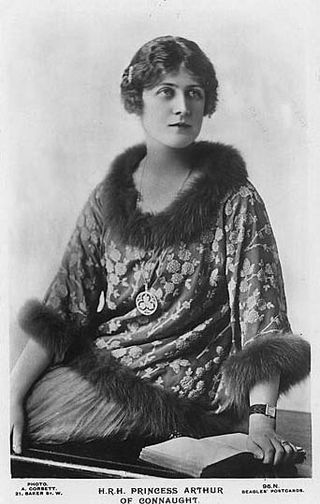
Princess Alexandra, 2nd Duchess of Fife, born Lady Alexandra Duff and known as Princess Arthur of Connaught after her marriage, was the eldest surviving grandchild of King Edward VII and also the first cousin of George VI. Alexandra and her younger sister, Maud, had the distinction of being the only female-line descendants of a British sovereign officially granted both the title of Princess and the style of Highness.
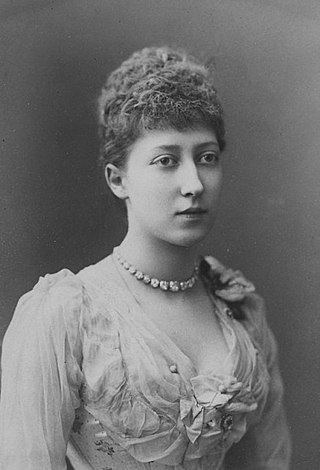
Louise, Princess Royal and Duchess of Fife was the third child and eldest daughter of King Edward VII and Queen Alexandra of the United Kingdom; she was a younger sister of King George V. Louise was given the title of Princess Royal in 1905. Known for her shy and quiet personality, Louise remained a low-key member of the royal family throughout her life.
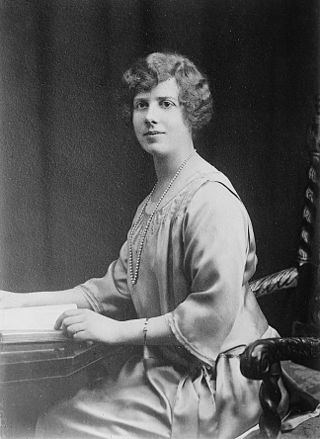
Maud Carnegie, Countess of Southesk, titled Princess Maud from 1905 to 1923, was a granddaughter of Edward VII. Maud and her elder sister, Alexandra, had the distinction of being the only female-line descendants of a British sovereign officially granted both the title of Princess and the style of Highness.
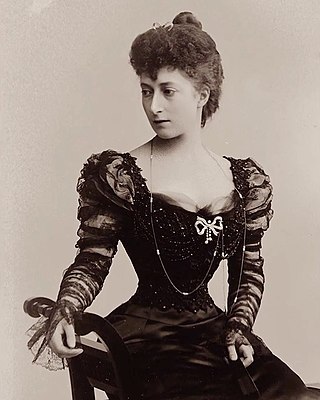
Maud of Wales was Queen of Norway as the wife of King Haakon VII. The youngest daughter of King Edward VII and Queen Alexandra of the United Kingdom, she was known as Princess Maud of Wales before her marriage, as her father was the Prince of Wales at the time.
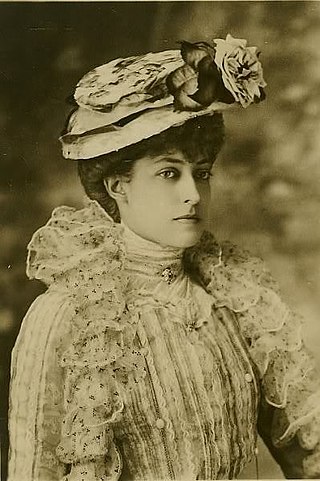
Princess Victoria was the fourth child and second daughter of King Edward VII and Queen Alexandra and the younger sister of King George V.

William Powell Frith was an English painter specialising in genre subjects and panoramic narrative works of life in the Victorian era. He was elected to the Royal Academy in 1853, presenting The Sleeping Model as his Diploma work. He has been described as the "greatest British painter of the social scene since Hogarth".

The use of the title of Princess of the United Kingdom of Great Britain and Northern Ireland is entirely at the will of the sovereign, and is now expressed in letters patent. Individuals holding the title of princess are styled "Her Royal Highness" (HRH). The current letters patent were issued in 1917 during the First World War, with one extension in 2012.

The wedding of Prince Charles and Camilla Parker Bowles took place in a civil ceremony at Windsor Guildhall, on 9 April 2005. The ceremony, conducted in the presence of the couple's families, was followed by a Church of England Service of Prayer and Dedication at St George's Chapel. The groom's parents, Queen Elizabeth II and Prince Philip, Duke of Edinburgh, did not attend the civil wedding ceremony, but were present at the Service of Prayer and Dedication and held a reception for the couple in Windsor Castle afterwards.

Victoria Constance Mary Somerset, Duchess of Beaufort, CStJ was a British peeress and sportswoman. The elder daughter of the 1st Marquess of Cambridge and Lady Margaret Grosvenor, she was the niece of Queen Mary.
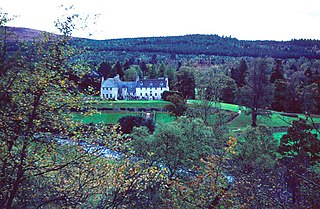
Birkhall is a 210 km2 estate on Royal Deeside, Aberdeenshire, Scotland, owned by King Charles III. It is located alongside the River Muick to the south-west of Ballater.

Queen Elizabeth II owned a historic collection of jewels – some as monarch and others as a private individual. They are separate from the gems and jewels of the Royal Collection, and from the coronation and state regalia that make up the Crown Jewels.

On 6 July 1893, Prince George, Duke of York, and Princess Victoria Mary of Teck were married at the Chapel Royal, St. James's Palace, in London, England.

The wedding of Princess Elizabeth and Sir Philip Mountbatten took place on Thursday 20 November 1947 at Westminster Abbey in London, United Kingdom. The bride was the elder daughter of King George VI and Queen Elizabeth as well as the heir presumptive to the British throne. The groom was born a Greek and Danish prince; he stopped using these foreign titles on his adoption of British nationality four months before the announcement of their marriage and was made Duke of Edinburgh, Earl of Merioneth and Baron Greenwich on the morning of the wedding.

The wedding dress of Princess Alexandra of Denmark was worn at her wedding to Albert Edward, Prince of Wales on 10 March 1863 in St George's Chapel, Windsor Castle. It was the first in British royal history to be photographed while being worn. The gown was made by London dressmaker Mrs James of Belgravia. It is now part of the British Royal Collection. In 2011, the dress was part of a display of royal wedding dresses at Kensington Palace.
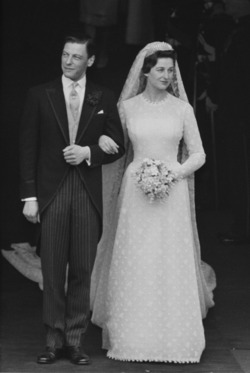
The wedding of Princess Alexandra of Kent and The Honourable Angus Ogilvy took place on Wednesday, 24 April 1963 at Westminster Abbey. Princess Alexandra was the only daughter and second child of Prince George, Duke of Kent, and Princess Marina of Greece and Denmark, while Ogilvy was the second son and fifth child of the 12th Earl of Airlie and Lady Alexandra Coke.

The wedding of Albert Edward, Prince of Wales, and Princess Alexandra of Denmark took place on 10 March 1863 at St. George's Chapel, Windsor Castle. It was the first royal wedding to take place at St. George's, and the last wedding of a prince of Wales until Prince Charles and Lady Diana Spencer's 1981 wedding.
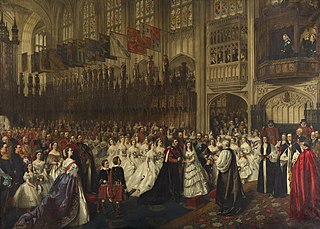
The Marriage of the Prince of Wales is a painting by the British artist William Powell Frith. It depicts the marriage between the Prince of Wales, the future Edward VII, and his Danish bride Princess Alexandra on 10 March 1863. The wedding took place at St George's Chapel in Windsor Castle. Frith began work in 1863 and completed the painting in 1865, when it was exhibited at the Royal Academy's Summer Exhibition. Frith was known for his paintings of crowd scenes, notably The Derby Day and The Railway Station. He was commissioned by Queen Victoria to paint the event and he attended the ceremony to sketch the scene, also working from photographs taken on the day. The Queen appears in the top right hand corner of the scene, while the two boys in tartan in the foreground are her youngest sons Prince Arthur and Prince Leopold. Other figures in the painting include Charles Longley, the Archbishop of Canterbury who performed the ceremony, and the Princess Royal. Frith was paid a fee of £3,000 for the painting, while the art dealer Louis Flatow bought the copyright for £5,000.




















